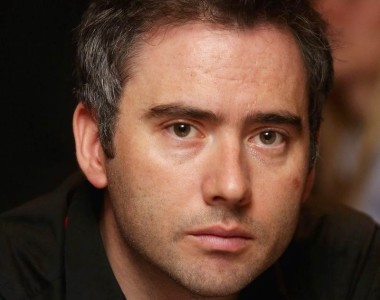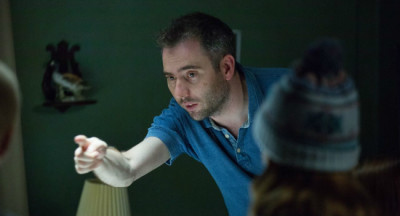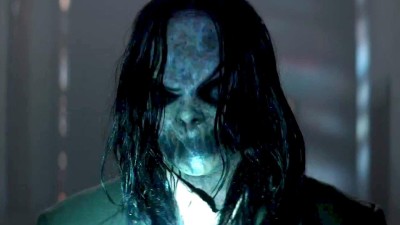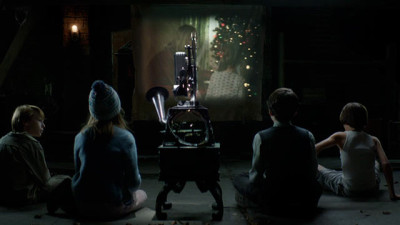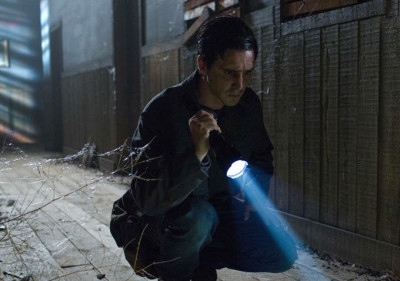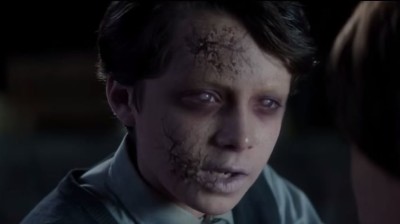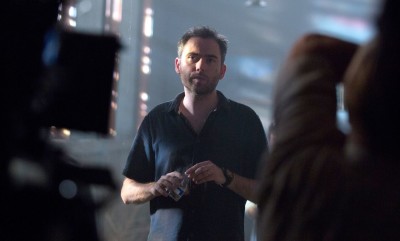It’s never easy to direct a film, let alone be “the new kid on the block”. It’s even more daunting to come on board an established franchise and on top of that, have it be part of the Blumhouse arsenal. But that’s exactly what Ciaran Foy did with SINISTER 2. With that in mind, and with the film safely finished and under this belt, I sat down for this exclusive interview with Foy to talk about all things “sinister”.
Did you have any kind of trepidation stepping in to the SINISTER franchise? Obviously, once we get past 1, we’ve got 2 coming and we’re looking at franchise. And it’s Blumhouse.
Right. I was initially quite anxious from a number of standpoints; one of them being the fact that the creator of this franchise [Scott Derrickson] was gonna be a producer and a writer, and how would that work. Would there be collision there? That anxiety went away very quickly when I was on set and he would see what my choices were and what I was doing and how I was directing the actors. Scott would say himself that “Citadel” gave him the confidence that I could make a movie like this, but seeing me on set was a great source of relief to him. He was like, “Yea. This guy’s got it.” I think because it is a Blumhouse movie and because it’s quite a low budget and you have 30 days to make the movie – I had 23 days on “Citadel” and this was 30 days – this is kind of a little bit easier.
But on top of the inherent logistics of directing any film, let alone being a horror film for Blumhouse, you’re working with seven kids in this movie.
Kids’ schedules means you’ve got pretty much half a day with them. So you’re block shooting and it’s messing up your schedule and we’re shooting 4, 5 pages a day. That can be hard because you want to make the movie visually interesting so you have to have the courage of your convictions that actually this shot that I see in my head where we track into this table and pan off to the left, for example, that that will cover the scene and we’ll get a reaction shot and we’ll move on. You’re so nervous that you almost have to fight the instinct to just play it safe and shoot a wide shot and then a close up and then a wide shot and a close up which would make it a visually boring movie. So, I think that’s another thing on “Citadel” was a big lesson that I took to this movie – almost cutting the movie in your head before you shoot. My background is in editing and I think that serves me well on such a tight time frame. And I was also nervous about the fact that this is a sequel and there’s a certain established tone to the movie. How do I pay homage to that without repeating it? Every director is different and no matter what I do, I’m not trying to ‘ape’ another guy’s work. It’s got to be it’s own thing. Scott was very encouraging with that. He was like, “This is your movie. Go run with it.” But I also knew that there’s a lot more comedic beats in this than in the first. And James [Ransone] is a very funny guy and some of those [beats] we came up with on set and others were on the page; some survived the edit and some don’t. But getting that balance right so that those moments hit but at the same time it felt like a SINISTER sequel with the right amount of feeling of dread and the disturbing quality to the kill films – getting that tone to work where you’ve got such an emphasis on children, they’re sort of the main characters in the movie, and the relationship between Dylan and Milo was at the center of it – and you could argue that Milo’s the real villain in the movie; Baghuul is there, he’s back, but he’s more a puppetmaster specter in the background manipulating things, but Milo was the face of the antagonist. So, what was different about this than the first SINISTER, they made me nervous because I knew I had to make a movie that would appeal to fans of SINISTER and what they liked about and setting that tone and also from the performances and how authentic they felt in the first movie, that’s something I wanted to bring to this. That’s something all my favorite horror films have this authentic real feeling behind the drama. But to take these components and get that mix right so that the end movie has a nice balance between the drama, the comedic and the terror.
One of the great things about SINISTER 2 is that we actually see more Bughuul here. But in seeing Bughuul, having Nick King reprise the performance again with the prosthetics and costume, his physical nuance is minuscule, but with the hands spreading and the stiffness, the deliberateness of the nuance tells and speaks volumes. It says so much about what is unfolding or the telepathic manipulation of Milo. How important was it to you to have Nick come back as Bughuul? Granted, he’s in prosthetics, but so often filmmakers might have somebody else come in to step in and do something but the physicality, the essence, is never right.
That’s quite right. Absolutely. I think there was one day that we had a stand-in for Nick. It was a kind of mess up on behalf of a few people. But the schedule didn’t say that Nick was due on a day he was due. We had a stand-in for Bughuul instead and we put the prosthetics on him. But, it’s surprising. He’s just standing there in the background and he was to do this thing where he brings the rats forward with his hands, and it just felt wrong. It looked like Bughuul but it felt wrong. In the end, we had to go back and shoot it again with Nick. I’m doing very little direction with Nick. He is Bughuul. He knows that character inside out. So once he understands what the shot looks like and what I’m trying to do, because once he comes to set in his full prosthetic he can’t see anything. But I go through the shot with him before he goes off into make-up and tell him “This is what I’m gonna do”. He just brings it. Nails it.
Do you think it helps his performance when he cannot see; much like in the film’s climactic scene, that we’re not going to talk about because it is a spoiler, with actors heads’ covered with burlap bags? Do you think that helps fuel and add realism and authenticity to the performances that you got from your actors?
Absolutely. I think that people in the “kill films” – each “kill film” except for the snow one and the electrocution – people have bags on their heads. I think that a lot of performers that we got for those kills, they’re extras. You can’t say “We’re gonna cast a bunch of people for the family that are going to be electrocuted, for instance.” But I think that in doing that, in making the scenario feel real, absolutely you get a more authentic performance. And I think the way that those “kill films” were shot – I have a pretty good idea of how I’m going to shoot everything in the movie. I’ll shot list and I’m lucky if I get 60% of that shot list. But how I approached the “kill films” was that I didn’t even think about how I was going to shoot them until I was there on the day. I said to myself that there is a 10-year old shooting this movie and because we create the scenario, it’s not like we’re shooting on a two-wall set. It’s there. It’s happening right in front of us and you have to light the room so we can just walk 360 degrees around it. [I]t’s right there in the moment, that’s when I’ll come up with [the scene]. If I was 10-years old, what would I do? Would I walk over here and get this angle or whatever. So you’re kind of ad-libbing it. But because that whole mise-en-scene is real and is organic, I think the performers totally feel it. We played some creepy music on set as well which helps them to get into the right zone. I think making the world real you’re gonna get a more powerful performance.
Along with the realism, you also create a real timelessness in the look of the film. The decision to use anamorphic lenses, for example. How important was that to you to get that cinematic texture and grain that we associate with the genre and the franchise – it could be the past, it could be the present – it adds a whole other level of suspending disbelief.
Right. Yeah. In “Citadel” I had the same objective which was to create a timeless feel; timeless in a sense that even in a movie like “Children of Men”, there’s something about the costumes in that that it could be from the 70’s, it could be from the 90’s, it could be from 20 years from now. I think that timelessness adds a really subtle “Twilight Zoney” feel of disorientation. We don’t quite know when and where we are. I think when you’ve got the more modern touches you put into things or the more modern speak you put into things. . .the more you do that, the more you date the movie. The anamorphic thing was something that actually began as a conversation with Bill Boes, production designer. We were talking about some of the design in “Close Encounters”, I think, and Bill was referencing the house in “Close Encounters”. We were talking about mixing up some eras because ultimately, they had moved into a house that hasn’t been occupied since the 70’s. So we talked about that. Then I spoke about the anamorphic lenses and how I would love to use lens flare and stuff like that because for me anamorphic always says “movie”. Bill was like, “You should shoot on anamorphic.” I knew there were so many visual effects in this movie, a lot of visual effects in this movie, like 200 shots, so I knew that anamorphic is always a bit more of a headache for CGI artists and I thought I’d be told no we can’t do that. But when Amy [Vincent] came on board, she was “Absolutely. It has to be anamorphic lenses.” So, yea, we shot with them. It was so cool shooting with them.
Talk about the church. I know it’s a converted old barn. What were your thoughts with Bill Boes in designing that? It is so exquisitely designed with the stained glass windows and the altar and even the hardwood floors and some of the light streaming through the stained glass. It is so cinematic, so beautiful. What did the two of you discuss to arrive at this look and design?
Well, myself and Bill tend to talk a lot about emotion and what we want people to feel as opposed to how cool something looked. We spoke about what kind of church this would be. We spoke about the color because for us the color of red or rust was the color in the movie of something that’s tainted, “that which is tainted” we said. So if you notice in the movie, Clint is always in different shades of red. So is Zach. The opposite of that was blue. Dylan and SO & So wore shades of blue.
It also appears that Milo and the “ghost kids” wear blue.
The funny thing with Milo was that the light on him was slightly blue, but his costume was shades of grey. That’s something we did with the “ghost kids”. Give them different shades of grey. But we spoke about what kind of color we would have. The church is made up of pretty much reds and blues. I’m a great believer in how things can have a subconscious effect on an audience. One thing that Bill brought to it was that we spoke about Bughuul and is there anything iconic about him that stands out in his silhouette, for instance. And Bill pointed out the fact that his eyes in silhouette make this perfect triangle on its side, so that shape became huge. That’s the shape that’s underneath the stairs, that’s in the rectory. It’s all over the church. It’s the shape of the wood in the basement. It’s in Clint’s house. It’s in the shape of the stained glass windows. It’s all over the movie. And people hopefully should not notice that, but I think when someone like So & So is sitting in the house going through photographs and if you look at the framing he’s actually in Bughuul’s eye, I think it has a subconscious effect on the audience. So that’s all over the movie. But that set that he built was a work of art. Again, we’ve got some small change to make this with and he created this church very quickly and like a weird origami shape that could very quickly fold and bend to become the corridors for where So & So was searching and then becomes the Sunday School classroom where Dylan hides and stuff like that. We ended up getting essentially three sets out of one set. He’s such a great production designer.
As you sit back now and reflect with your second major feature under your belt, what is the greatest gift that directing gives you? And especially directing a film like SINISTER 2.
For me it’s always about the audience. I have no intention of ever making a movie that is for me and for my friends. It’s almost like that movie “The Prestige”; it’s about the look on their faces. That’s why I do it. It’s that kick you get out of seeing them react to a movie; seeing them emotionally react. I think with comedy it’s as hard to get an audience to genuinely have a belly laugh as it is to have an audience feel scared of something. We’ve seen so much of it; we’re slightly desensitized to things. To do something in a fresh way that’s gonna affect people and get under their skin and stay with them for days is a hard thing to do. One thing I just love, especially with this movie, was at the test screenings. I’ve only seen this at test screenings with an audience and we had three test screenings all together, but it’s always been just this joy to not look at the screen – I’ve seen the movie 200 times – but to look at the audience and see how invested they are in it! Occasionally you’ll see somebody wipe a tear away which is like, “What?!” That’s just something I was not expecting. That can be quite a cathartic experience.

